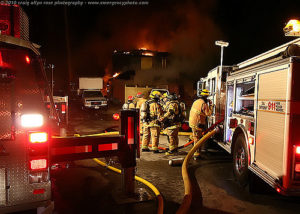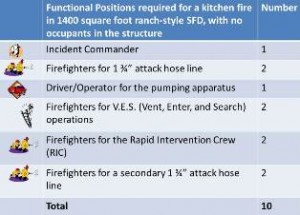By: Robert Avsec, Executive Fire Officer
“People will do something—including changing their behavior—only if it can be demonstrated that doing so is in their own best interests as defined by their own values.” ― Marshall Goldsmith, What Got You Here Won’t Get You There: How Successful People Become Even More Successful
Last week I reposted a blog that I wrote back in 2015, Fire Prevention and Suppression: The Fire Service’s Identity Crisis, as the topic is still quite relevant in my opinion. Among the many comments that the post received on LinkedIn and Facebook were a couple from my fire service and LinkedIn colleague, Patrick Coughlin. Here are a couple of Patrick’s comments that I think tie-in nicely with the discussion:
Manual Fire Suppression Operations
I am preparing a magazine article that explains the importance of public [fire and life  safety] education and [fire prevention] codes by showing the limitations of manual suppression [operations].
safety] education and [fire prevention] codes by showing the limitations of manual suppression [operations].
It will stress the following reality: few fire departments comply with NFPA 1710 [Standard for the Organization and Deployment of Fire Suppression Operations, Emergency Medical Operations, and Special Operations to the Public by Career Fire Departments] or NFPA 1720 [Standard for the Organization and Deployment of Fire Suppression Operations, Emergency Medical Operations and Special Operations to the Public by Volunteer Fire Departments], achieving compliance would be very costly and, complying will produce marginal results in outcomes.
I will then link public education and codes to reducing the number of critical tasks at fires, demonstrating that they are more cost-effective in improving public fire protection.
Providing Adequate Fire Department Staffing
The township is in an ideal location to improve staffing without hiring more career firefighters. A few hundred US fire departments now use military-style staffing, where they augment cadres of career firefighters with temporary ones. The temps work full time for 4-6 year periods and receive benefits ranging from free housing to free college educations in return. When they complete their obligations, about one half of them decide to become career firefighters. I have described some of those fire departments at www.fdexcellence.com, and will have an article about the concept in the July 2016 edition of PM Magazine, which is published by the International City Managers Association.
See Related: Top 25 Firefighter Intern Profiles on LinkedIn
Matching Fire Protection Strategy with the Risk
I see many parallels between the U.S. Army and the fire service’s continued focus on a suppression-centric fire protection strategy. The Army had for years–and to some extent still does today–been preparing for the next war on the European continent against the U.S.S.R. even long after there was no U.S.S.R.
When faced with the realities of today’s warfare against groups like al Quada and ISIS…the Army’s had to do a lot of catching up in terms of strategies, equipment, training, etc. That “retooling” has focused on a strategy of smaller and more quickly deployable units with more operational capabilities. But even with that, the U.S. Army still has a large commitment of resources toward large-scale battlefield resources, e.g., tanks and heavy artillery, despite the continued evidence that smaller regional conflicts have become the norm for combat deployments.
Fire departments, large and small, continue to devote the large majority of their resources to big equipment, e.g., today’s engines and aerial apparatus, without a closer examination of the fire risk in their communities. And they’re doing so with less available staffing than ever before.
 A safe, efficient and effective interior fire attack for a kitchen fire in a 1,400 square foot single-family dwelling requires a minimum of 10 firefighters. Why do departments “cling” to a fire suppression strategy that’s so people-intensive when they don’t have the people?
A safe, efficient and effective interior fire attack for a kitchen fire in a 1,400 square foot single-family dwelling requires a minimum of 10 firefighters. Why do departments “cling” to a fire suppression strategy that’s so people-intensive when they don’t have the people?
Why do fire departments, particularly volunteer-staffed departments, roll apparatus, e.g., a 1000 GPM Type I Engine, with only one or two people aboard? Why do those departments continue to invest huge amounts of money in fire apparatus that’s probably capable of being used to less than 10 percent of its capability?
There are more cost-effective alternatives available today that would enable departments to get more “bang for the their buck” for both people and equipment. Compressed-air foam systems (CAFS) can provide “big time” fire suppression capabilities for smaller and nimbler fire apparatus.
Concerned about Your ISO Rating?
Many say that using smaller apparatus would negatively affect a community’s ISO rating, resulting in higher insurance premiums for homeowners. That may or may not be the case according to some eye-opening research on the topic.
In 2006, Chris Orman completed an applied research project, “The Impacts of Changes in the use of ISO Ratings by Insurance Companies Serving North Monterey (Calif.) County,” as part of the National Fire Academy’s Executive Fire Officer Program.
Orman found that the majority of residential and commercial insurance underwriters have significantly changed how they calculate property insurance premiums. Those companies had either completely migrated away from using the ISO’s Public Protection Classification or were continuing to the use it as only one of several factors for calculating premiums.
See Related: Are American fire trucks too big?
Today, insurance companies are more likely to employ a subzone rating factor system that is a theoretical risk evaluation that uses the actual property loss within a zip code. When using a subzone system, the insurance underwriter takes into account all property losses due to all hazards, like fire, flood, lightening, hail, etc.
It appears that ISO is still being applied, but not stringently so. Insurance companies across the board believe that proximity to a paid fire station is of utmost importance…. Businesses and industry are not likely to factor in the capabilities of a local fire department because it cannot be assumed that the local fire department will be effective regardless if they have a PPC [ISO rating] of 5 or 1. (Orman, 2006).
 Fire & EMS Leader Pro The job of old firefighters is to teach young firefighters how to become old firefighters!
Fire & EMS Leader Pro The job of old firefighters is to teach young firefighters how to become old firefighters!